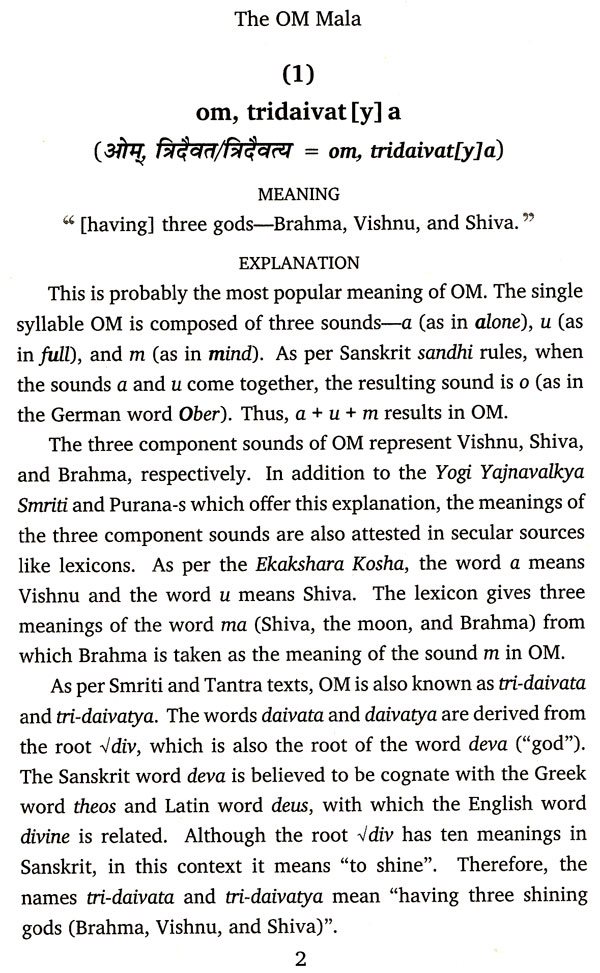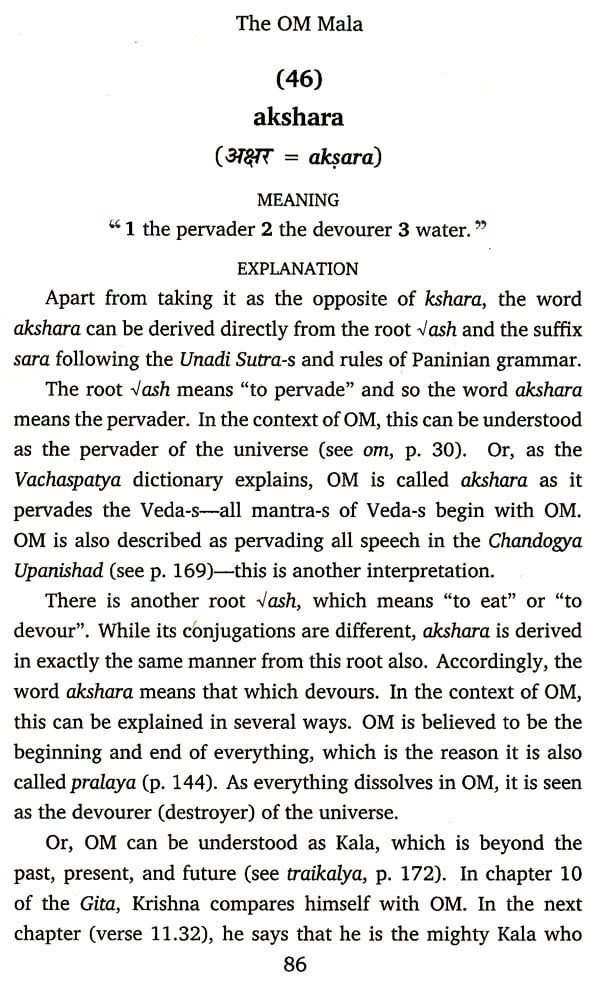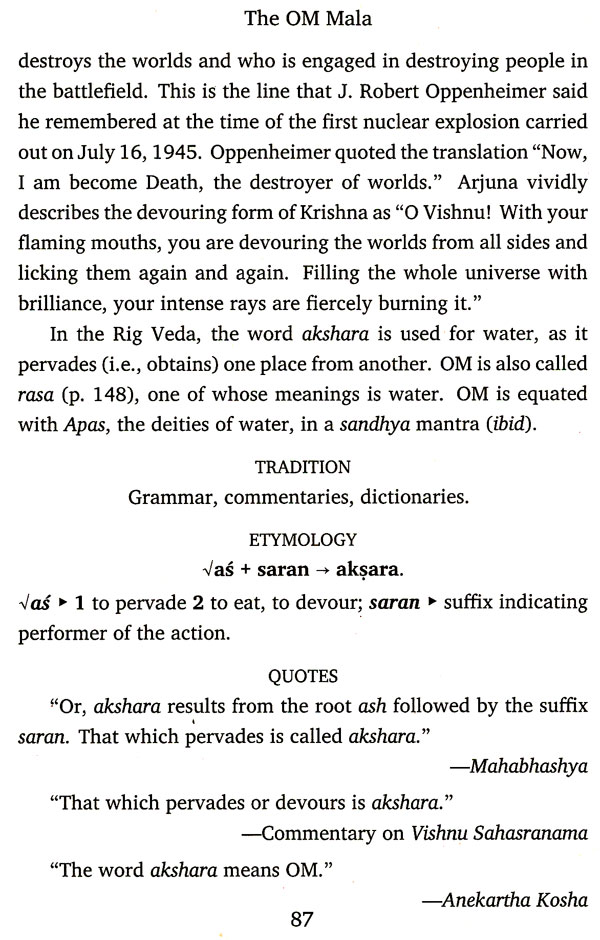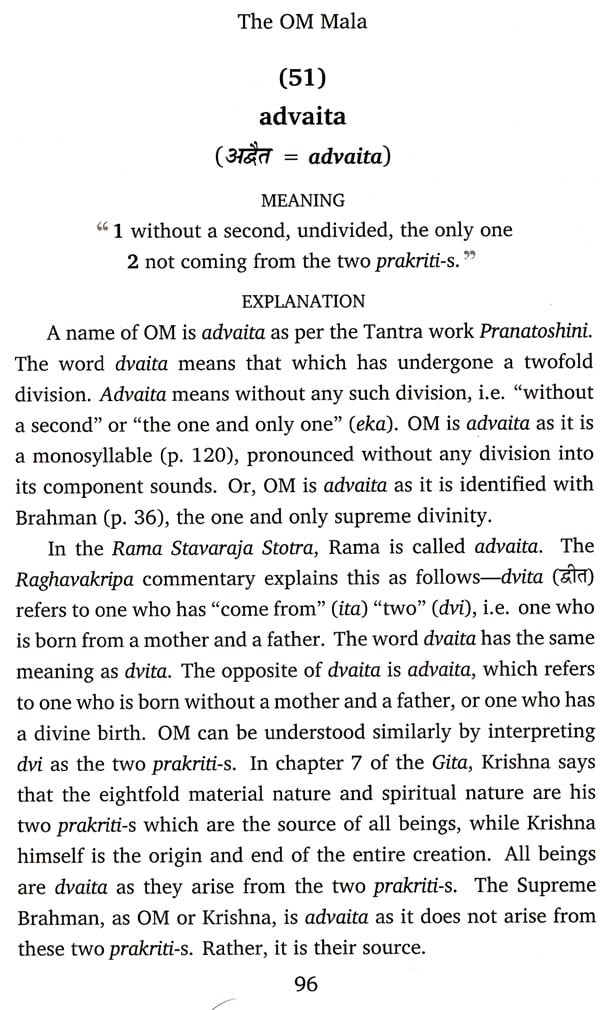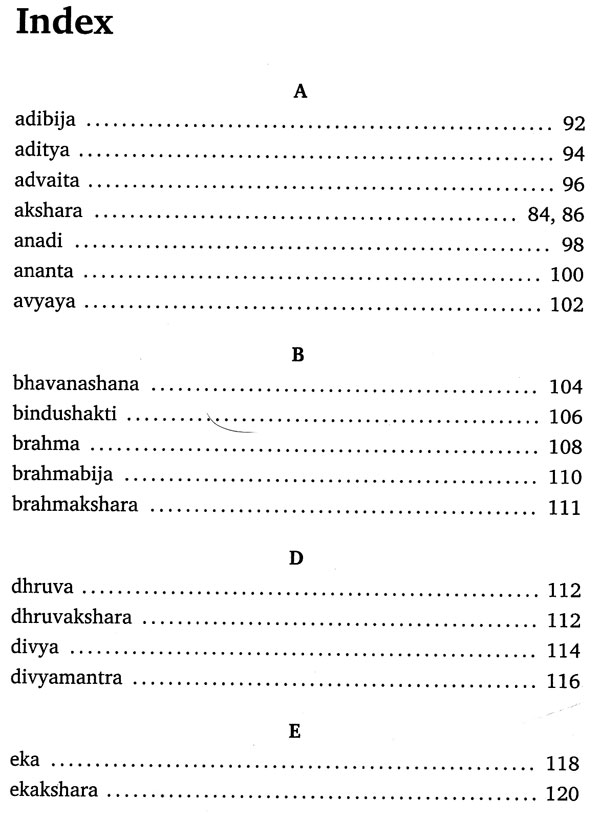
The Om Mala (Meanings of The Mystic Sound)
Book Specification
| Item Code: | NAQ904 |
| Author: | Nityananda Misra |
| Publisher: | Bloomsbury Publishing India Pvt. Ltd |
| Language: | English |
| Edition: | 2018 |
| ISBN: | 9789387471849 |
| Pages: | 232 |
| Cover: | PAPERBACK |
| Other Details | 8.00 X 5.20 inch |
| Weight | 190 gm |
Book Description
The OM Mala is a book (and a mala or a rosary) about just one word-OM. OM is one of the shortest Sanskrit words, and yet is perhaps the most powerful one, besides being a globally recognized mystic mantra.
The OM Mala gives 84 names of OM from Sanskrit texts and explains their meanings in 109 sections or beads: 108 chanting beads and one 'sumeru' bead. Each bead offers the meaning(s), explanation, traditions, etymology, and quotations for one or more names of OM. The book covers rare names of OM like 'shrutipada' and 'rasa' as well as common names like 'om 'udgitha', and 'pranava'. Popular meanings (like Brahma-Vishnu-Shiva) and rare meanings (like inhalation, holding the breath, arid exhalation) are included.
The book contains teachings and narratives related to OM from Veda-s, Upanishad-s, Smriti-s, Purana-s, Ramayana, Mahabharata, Gita, Yoga, Tantra, Vaishnavism, Shaivism, and Shaktism. Pearls on OM from poems, plays, and works on music and Ayurveda are presented. The use of OM in Yogic breathing and meditation is explained and the explanations/relevance of OM in Jainism, Buddhism, and Sikhism is briefly touched upon. The OM Mala is a mini-encyclopaedia on OM and associated concepts in Indian religions and culture.
This is a special book, for it is written to explain just one word-OM. And yet, this book is not even the tip of the iceberg. I have spent hardly a few months on this book, whereas even a lifetime is not sufficient to understand OM. The Madhyandina Samhita of the Shukla Yajur Veda ends by proclaiming that OM is the Brahman, the sky. The metaphor is apt, for there is no limit to the infinite sky and likewise there is no limit to the meanings of OM. OM is the topic of deliberation in many Upanishad-s, the crest-jewels of Indian philosophy. OM is described vividly in the Smriti-s, which follow the meaning of the Veda-s-as Kalidasa states in the Raghuvamsha. OM is praised in the Ramayana and the Mahabharata, the two unparalleled epics of India. OM is described in many ways in the Purana-s, the bedrock of Hinduism and Indian culture. OM is extolled in the philosophy of Yoga, the gift of India to mankind. OM is celebrated in Tantra, the esoteric and mystical spiritual path. OM is the object of devotion in Vaishnavism, Shaivism, and Shaktism-traditions enlivened by bhakti. OM is a part of chants in Jainism and Buddhism and is also prominent as the one word, or lb Onkar, in Sikhism. OM commands the reverence of all major sects of Hinduism and all major religions of India. No book, therefore, can even remotely present a complete picture of this mystic sound which yogi-s "always meditate upon", as a popular verse says. So what is this book about then? OM is known by countless names in Sanskrit texts, and most of these names can be interpreted in several ways. This book presents eighty-four names of OM and their meanings in accordance with multiple Sanskrit texts including not only Hindu scriptures but also secular texts like dictionaries, poems, plays, and treatises on music, grammar, and Ayurveda. While the names in this book are solely from Sanskrit texts and their meanings are also in accordance with Sanskrit grammar, I give examples from texts of other languages wherever appropriate. Apart from the Upanishad-s and the Purana-s, whose treatment of OM is the focus of many books, this book also draws from Sanskrit commentaries as well as Yoga and Tantra works which have explained OM and its names in many unique ways.
This book has 109 sections, each section presents one or more specific meanings for a single name or multiple related names of OM. Apart from the meanings, each of the 109 sections offers a short explanation, a list of corresponding traditions, and translations of relevant quotations from Sanskrit texts. Most sections also provide the etymology of the name(s) explained in the section. A mob used for chanting a mantra typically has 109 beads, of which 108 beads are used for chanting and the head bead (sumeru) is used to keep track of rounds of chanting. After every complete round of chanting, the direction of moving the beads is reversed. One round of chanting covers 108 beads, beginning with the bead on one side of the stoners and ending with the bead on the other side of the sumeru. The first 108 sections in this book are like the 108 chanting beads of a ma/a, and the last section is like the owners bead. As OM is essentially a Sanskrit word, best illuminated by Sanskrit grammar, this last section aptly explains nineteen meanings of the word OM as per the Sanskrit grammar tradition.
This book has many translations and explanations of Sanskrit words, phrases, sentences, and verses. I am a Vaishnava initiated in the tradition of Ramananda and have an unshakeable belief in the Vishishtadvaita philosophy. For me, as for millions of Ramanandi-s, Rama alone is the Supreme Brahman. Therefore, I have adhered to dualistic Vaishnava interpretations in my translations and explanations wherever there is a difference of opinion among interpreters. Most of the translations I offer are not literal (shabda-anuvada) but present the essence of the original text (bhava-anuvada). For additional clarity, I supply ellipsis wherever needed and also abridge the translations.
**Contents and Sample Pages**
